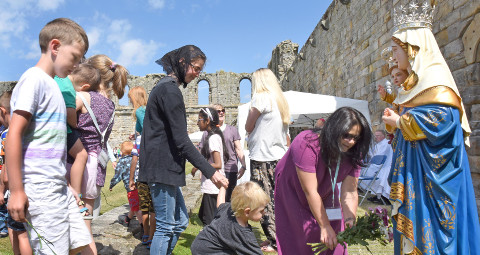BY Amanda Connelly | May 17 | ![]() 0 COMMENTS
0 COMMENTS ![]() print
print

The statue of Our Lady of Aberdeen that holds a remarkable story of survival and Faith
As the statue of Our Lady of Aberdeen continues its tour of the country, Amanda Connelly reveals its rich history and the hopes it embodies for Catholics, past, present and future.
This year, Scotland’s national image of Our Lady will make its way around all eight of the country’s Catholic dioceses.
Known as Our Lady of Aberdeen, she has already started on her way in a tour which it is hoped will inspire conversion and devotion.
The image of Our Lady of Aberdeen has a fascinating history, a connection to pre-Reformation Scotland perhaps unknown to many.
Lasting Faith
The wooden statue bears a remarkable story both of survival and lasting Faith that has endured across the centuries.
Made of oak and placed in the ancient St Machar’s Cathedral in the 1500s, the original can still be found today in a church in Brussels, Belgium, where it is named Our Lady of Good Success.
The story of how a statue from what was then a small north-east Scottish city found itself in a central Brussels church is a fascinating one.
Prayers to Our Lady
Gavin Dunbar, who was bishop of Aberdeen from 1518-32, asked Fr Alexander Galloway to design a bridge over the River Dee, but they could not decide where along the river to build it.
Bishop Dunbar prayed to Our Lady for inspiration and was presented with a vision of where the bridge should be built, and where it still stands today.
The bridge was completed in 1527 and the bishop subsequently dedicated a chapel in the Blessed Mother’s honour on the south side of the river.
To mark its dedication, a statue of Our Lady was borne from St Machar’s Cathedral to the new chapel.
Reformation
The advent of the Reformation, however, saw Catholics forced to surrender their beliefs or flee. Yet Our Lady of Aberdeen’s statue was sheltered by the faithful in Scotland, being surreptitiously moved from place to place and displayed at secret Masses.
For three generations the Gordons of Huntly sheltered the statue, risking their lives to protect it. But amid increasing difficulties, it was decided to send the statue abroad, safe from harm.
The ship which carried it across the North Sea in the 1620s was demasted in a storm.
As it drifted and the crew attempted to repair it, they were attacked by Dutch pirates, who were driven off by the ship’s Spanish guns. With Dutch ships blocking entrance to the ports of both Antwerp and Calais, Dunkirk was the next available option.
When it docked, battered from the storms the harbour master was surprised to see the ship had survived and noted that the crew praised the statue, having prayed to Our Lady for deliverance from the storm and the pirates.
Sent to Spain
The statue was immediately sent to Archduchess Isabella of Spain, ruler of the Low Countries. Having just won a battle, she attributed the victory to the arrival of the statue, naming it Notre Dame du Bon Succes.
Although Isabella wished to have the statue kept in the royal palace, she agreed to have it placed in the new Augustinian church in Brussels, where it remained until 1796 until being moved once again into private hands to avoid the fallout from the French Revolution.
Englishman John Morris returned Our Lady’s statue to the Augustinian chapel in 1805, where it stayed for the next nine years until being transported to the Church of Our Lady of Finisterre, where it is still venerated as Our Lady of Good Success today.
Prevailing
Devotion to Our Lady of Aberdeen has prevailed in the diocese and beyond, drawing on copies of the original statue, one of which stands proudly in the chapel of Our Lady at St Mary’s Cathedral in Aberdeen.
The statue now on tour was commissioned by New Dawn in Scotland for its annual conference and Rosary procession to the ruins of St Andrew’s Cathedral in the Fife coastal town of St Andrews, in honour of Our Holy Mother and our patron saint.
Carved and painted in the Indian port city of Mumbai from teak wood, it stands 4ft 6in high and was blessed by Archbishop Leo Cushley of St Andrews & Edinburgh, while Bishop Hugh Gilbert of Aberdeen Diocese offered a special crowning ceremony at St Mary’s in Aberdeen.
Scottish journey
As part of the New Dawn in Scotland’s prayer for the conversion of our country, the Bishops’ Conference of Scotland agreed that this year a statue of Our Lady of Aberdeen would chart its way around the eight Catholic dioceses.
It will be at St Margaret’s Cathedral in Ayr until Friday May 31—the feast of the Presentation of the Blessed Virgin Mary.
Having already visited the dioceses of Aberdeen, Dunkeld, Argyll and the Isles, Paisley and Motherwell,
Galloway marks the next diocese to receive the statue, and the prayers and intentions of the faithful.
A decade of New Dawn
This is the 10th year of New Dawn in Scotland, which will once again hold its annual conference in St Andrews, led by Bishop John Keenan of Paisley, in July.
On July 11 a procession will leave St James’ Church with the statue and a relic of St Andrew and make its way to St Andrew’s Cathedral for Mass at 11.30am. Other activities include a special event for young people.
New Dawn in Scotland was founded in 1987 by the late Myles Dempsey, and with its global mandate has been embraced around the world in countries including England, Czech Republic, Portugal, Slovakia, Uganda and Zambia, and is now planning to expand into Kenya and Poland.










